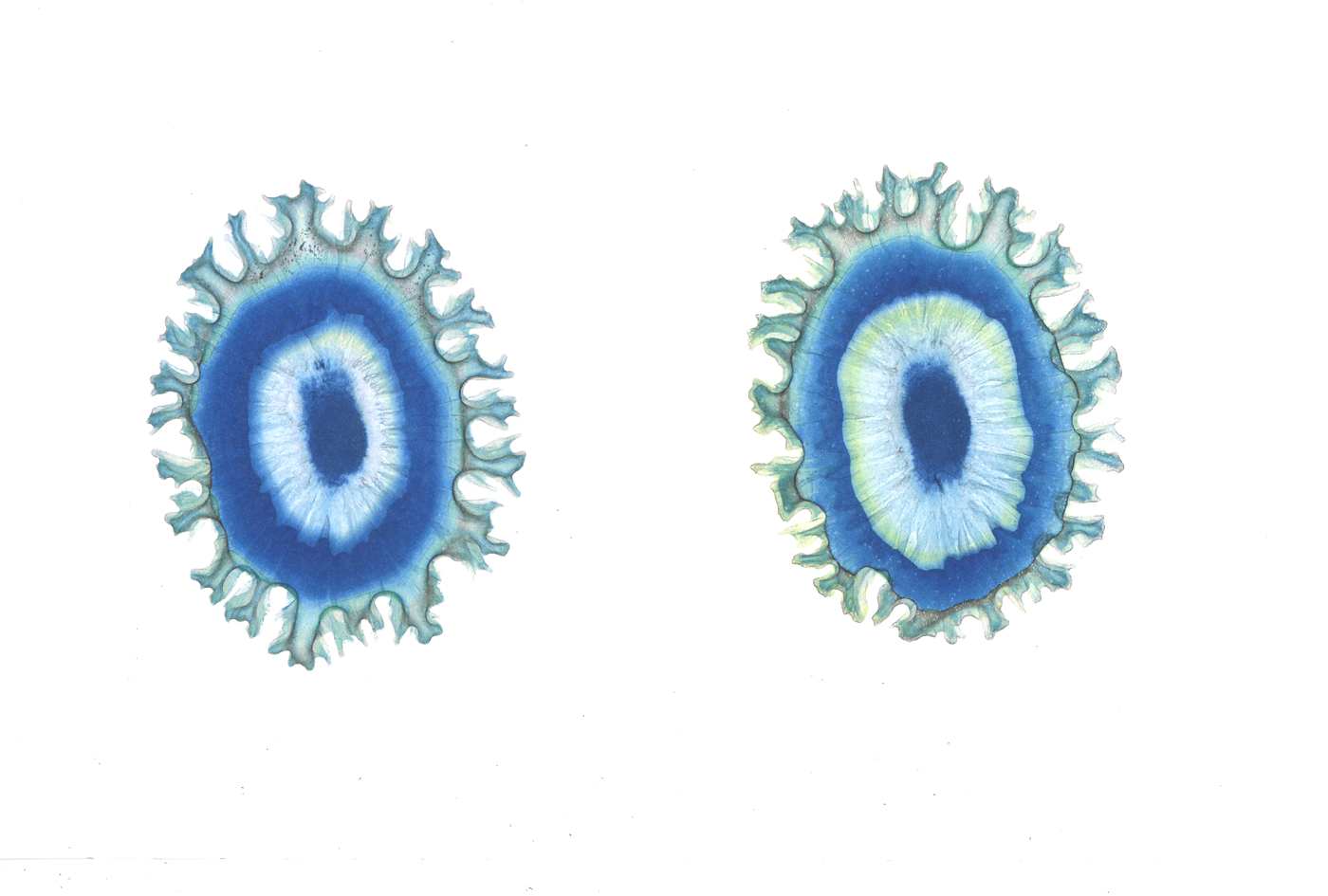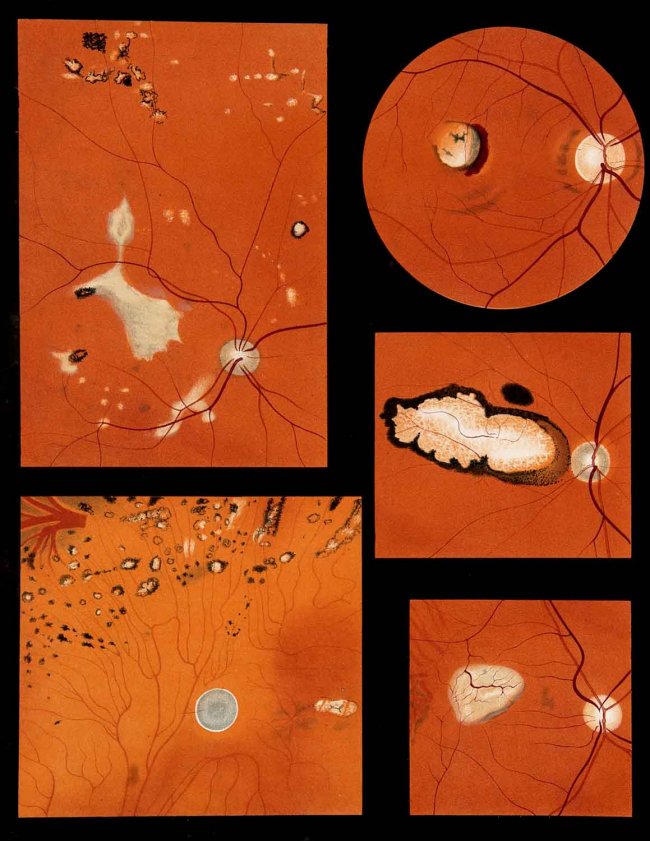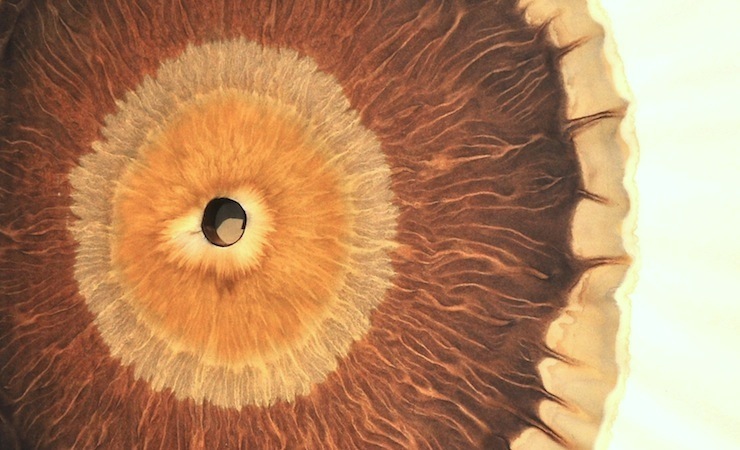— The Corruption of the Eye: On Photogenesis and Self-Growing Images

I see with sentient eyes, I feel with a seeing hand.
—Goethe, Roman Elegies, 17881Original quote in German: “[Ich] sehe mit fühlendem Aug, fühle mit sehender Hand,” translation by the author. Unpublished during Goethe’s life, this quote was first published only in 1914.
1. The Eye of the Stomach
“The skin, like a cloak, covers us all over, the oldest and the most sensitive of our organs, our first medium of communication, and our most efficient of protectors. The whole body is covered by skin. Even the transparent cornea of the eye is overlain by a layer of modified skin. The skin also turns inwards to line orifices such as the mouth, nostrils, and anal canal. In the evolution of the senses the sense of touch was undoubtedly the first to come into being. Touch is the parent of our eyes.”2Ashley Montagu, Touching: The Human Significance of the Skin (New York: Harper and Row, 1971), 3. Used to considering vision as a form of immaterial perception, as Ashley Montagu once noticed, we often fail to recognize the epidermic materiality that is specific to the eye.
When we gaze at the sun, for as long as the violence of light will allow, and then close our eyes, a diaphanous yellow spot emerges at the center of the visual field. This yolk-like afterimage is an effect impressed on the macula lutea (from the Latin “yellow spot”), a part of the internal eye that was discovered and described by medicine only around 1800. The macula lutea is the area of the eye with the highest density of cones, and thus the zone with the greatest acuity of vision in bright light. The macula’s yellow is made of pigments which absorb the high energy waves of blue and ultraviolet light in order to protect the eye from oxidative stress, that is, from the corruptive power of light. The afterimage of the sun appearing on the internal surface of the eye also tells of a millennial adaptation: the struggle of the organ of sight against the sun.
The human eye happens to derive the yellow protective pigments of the macula lutea—lutein and zeaxanthin—from the plant matter that we ingest either directly or indirectly (egg yolk, for instance, is a good source of lutein, which the chicken herself acquires from plants). Our macular pigment begins to form only after we are born, as a protection against the sun’s radiation in the world outside the womb. More interestingly, these protective molecules set a common ground, or rather an evolutionary legacy, between our organ of vision and the photosynthesis of the vegetable kingdom.
Essential to a plant’s photosynthesis itself, lutein and zeaxanthin are the most abundant carotenoid pigments in vegetation. During photosynthesis these pigments pacify chlorophyll molecules when they reach high levels of energy excitement, thus protecting the plant’s metabolism and tissues from photo-damage and overheating. Similar to a plant, the eye is not a simple aperture to absorb light, but a filter to mitigate external stimuli.
Our dependence on the ocular pigments that we absorb from plants divulges the materiality of vision and draws an epidermic continuum with the vegetable universe. While we deem vision as a sense that does not touch the world—our gaze is seemingly a sense at a distance, while senses such as taste and smell rely on direct visceral entanglements with whatever we inhale, touch, or chew—here we unveil vision as a process of chemical contamination and digestion stemming from plants. Vision is rooted in the materiality of digestion.
The human eye is an organ complicit with plant photosynthesis. In fact, seeing is a process of photosynthesis. As much as plant photosynthesis absorbs excessive light and turns it into the carbon structures of sugar molecules, the human eye has to mitigate light and turn it into the neural structures of vision, cognition, and memory. In this process the eye protects itself from the corruptive metabolism of light, tapping into some ancestral mechanism shared with plants. If the human eye protects itself like a plant, we can think of photosynthesis itself as a sort of primeval organ of vision spread out across the skin of the vegetable kingdom.3Plant photosynthesis is probably the most abused metaphor and analogy of life, widely quoted across a diverse spectrum of schools of thought to justify naturalist ideologies. It is believed that photosynthesis is behind a process of energy accumulation central to natural equilibrium and the food chain. However, there are various ways the process of light metabolism could be understood. It could also be understood as a process towards cosmic corruption and fermentation, or as a process towards more “complex architectures of light,” as recently discussed in this Supercommunity series; see Matteo Pasquinelli, “On Solar Databases and the Exogenesis of Light,” in “Supercommunity,” special issue, e-flux journal 65, Day 22 (June 4, 2015) →

2. Self-Growing Images
Any image, including the optical appearances we continuously fathom through the lenses of our eyes, is the corruption of a substance. There is thus an interesting material commonality worth exploring here: between the animal organ of sight, the living matter of the vegetable kingdom, and also the technical apparatuses of vision introduced by humankind. If lutein and zeaxanthin are the chemical filters that make possible our internal vision without being corrupted by the brutal force of light, other molecules—silver salts—have had a historical role as chemical catalysts in the first apparatus of external vision: namely, photography.
Whereas lutein and zeaxanthin protect us from light, silver salts, as we know, were used to catalyze and amplify light’s powers. Silver salts were first used to absorb and fix (possibly permanently) the memory of light on a flat substrate. In fact, early photographs were called “light pictures” and represented the attempt to imitate and incarnate an external organ of vision, an “external eye.” It is in the early experiments leading up to the invention of photography that we can find a forgotten track of our tie with the general metabolism of light.
A progenitor of the photographic technique, the “chromatogram” divulges an intriguing correlation between human vision and the organic world. The chromatogram was a technique derived from the experiments of German chemist Friedlieb Ferdinand Runge in the nineteenth century. Runge was looking for a way to reveal the chemical composition of different organic substances, such as plant matter and tar. He had the idea of mixing organic solutions with silver nitrate and absorbing these through fine filter paper. The chromatogram was drawn by the gradual and circular irradiation of colors on filter paper produced by the reaction of silver nitrate with organic matter and, more importantly, sunlight.
His experiments with silver nitrate belonged to the same pioneering ground that paved the way for modern photography. Yet the chromatogram was not used to record the surface of reality like photography would do—quite the opposite; it was instead used to reveal the internal chemical composition of matter. It expresses a relation between the inner nature of matter and its surface that we have probably forgotten, because of the hegemony of the flat perception imposed by photography and all the visual media that followed after it. In the chromatogram, a light reaction reveals the inner chemistry and transforms matter composition into visual patterns. Runge’s chromatograms were self-growing images, where the manifestation of inner substances was left to the autonomous reaction of the substrate with light, with no intervention of a mechanical and external point of view as with a camera obscura apparatus.
In the same period, Runge also won the attention of Goethe for having identified the molecule atropine in deadly nightshade, or Atropa belladonna (used by women in ancient Egypt and throughout the centuries to add brilliance to their eyes by dilating their pupils). At the time, Goethe was developing his theory of color perception, and when he heard about the mydriasis effect on the eye that this atropic juice produced, he invited Runge to his house in October 1819. The story goes that Runge turned up with a cat clutched under his arm to show Goethe the effect of atropine on the cat’s eye.4See the insightful account of Runge’s work in Esther Leslie, Synthetic Worlds: Nature, Art and the Chemical Industry (London: Reaktion Books, 2006). Runge dropped some Atropa belladonna extract in one of the cat’s eyes to show the quick dilation of the pupil. Goethe was very impressed by the dilation, and out of true excitement he gave Runge a bag of coffee as a gift (from which Runge discovered and isolated another important alkaloid for modern times: caffeine). A few days later, Goethe sent a letter to Runge asking him to come rescue his cat, which was apparently still ambling about Goethe’s house with one dilated pupil.

3. “Anch’io sono pittore!”
In the chromatogram, the radial image only fully emerges once the paper is exposed to indirect sunlight. It is therefore the sunlight which “draws” the image. As Esther Leslie reminds us: “It is almost as if the chemist does not participate in this image production, this chemical articulation, when chemistry itself announces, ‘Anch’io sono pittore!’, but more proudly than Michelangelo, for it does its work without a brush.”5Leslie, Sythentic Worlds, 58. The chromatogram is thus an example of exogenous or nonhuman aesthetics, for it is light itself that “paints” the chromatogram, which could technically continue to grow, provided its “chemical metabolism” keeps on reacting with sunlight. This is a different regime of visibility, or rather, of photogenesis, as here light is not just a stream of waves to be passively refracted and recorded but an active and autonomous medium of image-making. It is a medium in which organic substances become an aperture of their simultaneous dependence upon and defense against the sun.
![A spread extracted from Friedlieb Ferdinand Runge’s <em>Der Bildungstrieb der Stoffe, veranschaulicht in selbstständig gewachsenen Bilder</em> [The formative tendency of substances illustrated by autonomously developed images], (Berlin: Matthes & Seitz, 2014).](/site/assets/files/1320/blatt_1_4_5_7_runge.jpg)
The continuity between the human eye and the photosensitivity of plants’ metabolism could even be extended to the mineral kingdom, according to Runge, who believed in a common force that drives the becoming of both organic and inorganic matter. As Leslie writes: “For Runge plant chemistry provided evidence of the continuity of chemical forms, such that ‘phytochemistry is mineral chemistry repeated at a higher potency.’”6Leslie, Synthetic Worlds, 49. In another essay Runge “reflected on the harmony of animal life, and here he envisaged every organ as an animal in an animal, which grows with its mouth on the anus of another and uses its excretions as nourishment and produces excreta for another in similar fashion.” Ibid, 50.
In his book Der Bildungstrieb der Stoffe, Runge named the force that drives natural morphology and also the chromatogram’s Bildungtrieb, which can be translated as the “drive to formation.” He wrote in the conclusion of the book:
After everything I think I may now voice the assertion that, in the formation of these images a new, hitherto unknown force is active. It has nothing in common with magnetism, electricity or Galvanism. It is not excited or fanned by something external, but inhabits the elements from the very beginning and shows itself to be effective, when these balance out their chemical oppositions, i.e., combine and separate by elective attraction and repulsion. I call this force “the drive to formation” and consider this to be the model of the life force that is active in plants and animals.7Friedlieb Ferdinand Runge, Der Bildungstrieb der Stoffe, veranschaulicht in selbstständig gewachsenen Bilder [The formative tendency of substances illustrated by autonomously developed images], Oranienburg, self-published, 1855. New edition ed. Judith Schalansky (Berlin: Matthes & Seitz, 2014).
As Leslie comments:
Runge’s willingness to attribute a life force to chemicals is a continuation of Romantic natural philosophy but meshed with Goethean morphology and experiment. Runge’s natural philosophy, when it appeared at its most exposed form, emerged in the midst of close reference to the physical world and everyday life, embedded in wisdom about bad wine and hangovers and hints on the uses of sulfuric acids in the kitchen and for agriculture.8Leslie, Synthetic Worlds, 68.
![Original cover of Friedlieb Ferdinand Runge’s <em>Der Bildungstrieb der Stoffe, veranschaulicht in selbstständig gewachsenen Bilder</em> [The formative tendency of substances illustrated by autonomously developed images] (Berlin: Matthes & Seitz, 2014).](/site/assets/files/1320/der_bildungstrieb_der_stoffe_cover.jpg)
An embodied photograph of the plant, the chromatogram is an image which discloses its own bodily formation. Literally, it is a photosynthesis, but of a different kind. And, in an uncanny way, the developing chromatogram bears a resemblance to our prime medium of perception: the eye. Here our focus should shift from the eye as a globular organ in the head of a vertebrate animal to the eye as an epidermic lens, a light-mitigating organ that attenuates the visceral contamination of radiation. The radial chromatogram is a “solar dance” that bursts the stability of our borders of sight.9George Bataille, “Van Gogh as Prometheus (1937),” October 36 (Spring 1986): 59. As quoted by Charles Stankievech, “Supercritical Decay,” in “Supercommunity,” special issue, e-flux journal 65, Day 61 (July 29, 2015) → At its base, the radial chromatogram technique as conjured by Runge is an entry into another way of seeing the environment in which we live, revealing our inseparable alliance with plants and their mitigation against radiation in forming our sense-consciousness of the world. It is a reminder that vegetation fundamentally configures our propensity to see, and that our eyes are immersed within a vegetative metabolism of a kind. We look at plants, but plants have already cannibalized our gaze as they become part of us looking back at them.
×
I would like to thank Matteo Pasquinelli for sharing ideas and intuitions, Careof Milan for the residency opportunity to delve further into this research, and Matthes & Seitz Berlin for the imagery used in this text from their recently republished edition of Runge’s Der Bildungstrieb der Stoffe, 2014.


